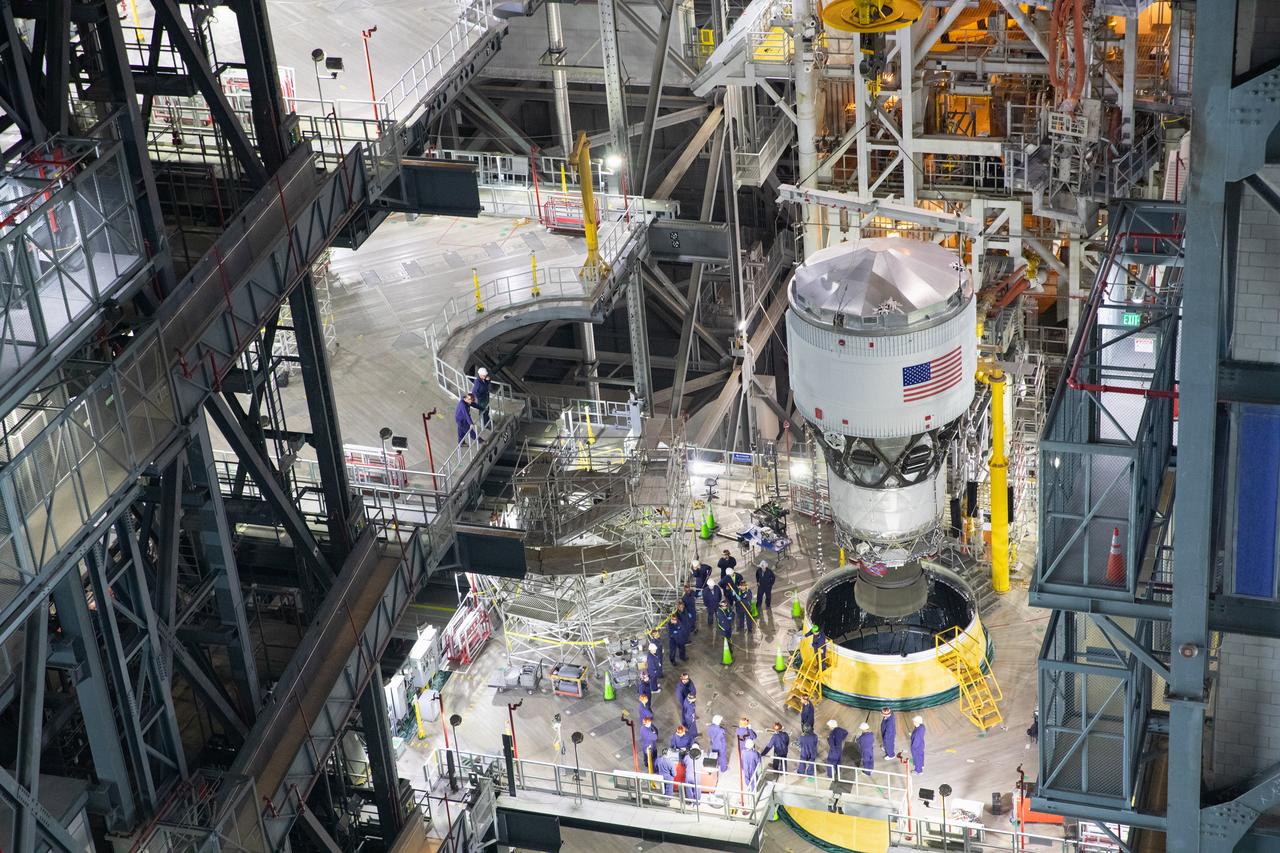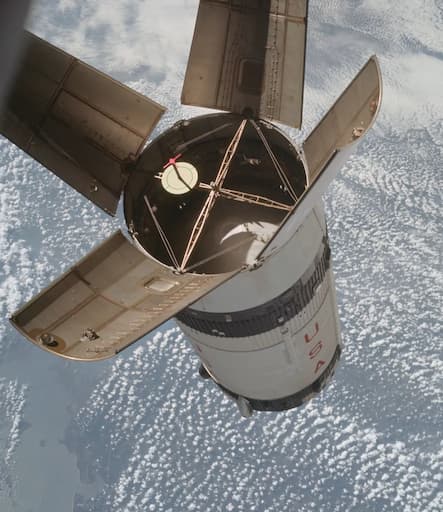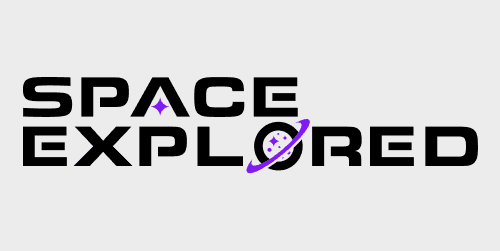
Boosters, stacked. Core Stage, stacked. Launch Vehicle Stage Adaptor, stacked. NASA’s Exploration Ground Systems (EGS) team has now stacked Artemis 2’s upper stage. The Interim Cryogenic Propulsion Stage (ICPS) is SLS’s second stage. It will carry Artemis 2’s crew into high Earth orbit. Once finished, the stage will be jettisoned and used for a docking test with Orion. After this, Orion will fire its AJ-10 rocket engine. Sending it on a journey around the moon and back to Earth. The mission is presently set for February 2026.
Core Stage Engine Swap
On April 19th, EGS removed SLS core stage RS-25 engine E2063 and replaced it with E2061. A hydraulic leak in engine E2063 caused the replacement. The engine swap should now be complete or nearly complete. This change added no notable delay to the launch date. This swap was expected; during core stage stacking, one engine already had removed paneling.
NASA has long dealt with RS-25 engine issues. The space shuttle program used three RS-25 engines per flight. The worst case involved an engine shutdown during one of 135 shuttle missions. Most problems triggered a launch abort and rollback to the VAB for repair or replacement.
A Troubled Start to Success
The ICPS comes from the Delta Cryogenic Second Stage (DCSS), used on Delta III and Delta IV rockets. JAXA and Mitsubishi Heavy Industries first designed the DCSS. Mitsubishi is the same group behind the car brand. They built the DCSS for the Delta III rocket. That vehicle evolved from the Delta II, featuring a larger upper stage. But the Delta III suffered multiple failures. All three launches failed due to technical issues. Still, the DCSS design was not scrapped.
Boeing (later ULA) adapted it for the Delta IV rocket. The DCSS then served as Delta IV’s upper stage. It flew successfully from 2002 through 2024. To meet varied mission needs, two versions were developed: one with a 4-meter and another with a 5-meter diameter. The DCSS completed 43 flawless flights. The only anomaly occurred in 2012 due to a fuel leak. Even then, the spacecraft still reached its target orbit. Being declared a success by the customer.
The ICPS Powering Artemis
ICPS is based on the 5-meter version of the DCSS. This larger design offers better support and energy for launching Orion. The ICPS carries 3,905 lb (1,771 kg) more fuel than the DCSS. That fuel load raises the mass fraction from 88.6% to 89.2%. The stage uses a single RL-10 engine. Earlier versions flew with the RL-10B2 model. Artemis 2 will debut the newer RL-10C2 engine. Orion first flew in 2014. That mission, Exploration Flight Test-1, launched atop a Delta IV Heavy. A DCSS stage supported the flight. That early flight helped NASA test hardware years before Artemis 1’s 2022 launch.
Artemis 2 and Artemis 3 will be ICPS’s only missions. As its name suggests, it is an interim solution. The larger Exploration Upper Stage (EUS) will replace it. ULA has ceased producing the DCSS and ICPS. Artemis 3’s ICPS was completed in August 2023.
Artemis 2’s ICPS debuts more than just a new engine. A docking target is also attached below its liquid hydrogen tank. Orion will use the target to test rendezvous and docking procedures. After separating, Orion will move away, rotate, and face the spent stage. It will then approach the docking target. However, no actual docking will occur, as Artemis 2’s Orion lacks a docking port.

The test on Artemis 2 closely mirrors Apollo 7 and Apollo 8 docking trials. In Apollo missions, the crew detached from the S-IVB stage. Then they moved forward, rotated, and aligned with the docking target. Even though no lunar module was present, simulated docking was performed. Apollo 7 especially, was a flight test of the new spacecraft performing a similar test, all while lacking a docking mechanism, just like Artemis 2.

What’s Next After the ICPS
Once stacked, the next step is adding the Orion Spacecraft Adapter (OSA). This short structural cone links the ICPS to the Orion Crew Module Adapter. The OSA also houses several cubesats. These will deploy after Orion separates from the rocket. After installing the OSA, the Orion spacecraft will be the final element to stack.
Inside the Neil A. Armstrong Operations and Checkout Building, Orion continues to advance.
Yesterday, Lockheed handed over the keys to NASA, both figuratively and literally, with an oversized key fob to commemorate the event. Before this, EGS installed three fairings around Orion’s Service Module. These fairings shield sensitive components from launch forces. Inside are four solar arrays, part of the European Service Module. These arrays generate power for Orion and sustain the crew. Orion also includes control thrusters for in-space maneuvering.
Next Step: Fueling
Next, Orion will be moved to the Multi-Payload Processing Facility (MPPF). There, it will be fueled with monomethyl hydrazine (MMH) and nitrogen tetroxide (MON-3). These toxic fuels power the AJ-10 engine and thrusters. Because of the danger, crews wear special SCAPE suits during fueling. SCAPE (Self-Contained Atmospheric Protective Ensemble) suits create a sealed, breathable environment. They shield crews’ eyes, lungs, and skin from contact or fumes. MMH causes burns on contact. Inhalation leads to coughing, irritation, headaches, and potential lung damage. MON-3 has similar effects. Inhaling it can cause fluid buildup in the lungs after 24 hours. It also damages internal organs if exposure occurs.
Final Steps for Orion
After fueling, Orion will move to the Launch Abort System Facility. Four protective panels will be installed there. These panels guard Orion from launch forces and the abort tower’s effects. Then, the Launch Abort System (LAS) tower will be stacked. Artemis 2’s LAS will fly fully functional for the first time. Earlier flights used inert abort systems. Exploration Flight Test-1 and Artemis 1 had only the jettison motors functional.
NASA tested the complete abort tower twice before. Pad Abort-1 in 2010 and Ascent Abort-2 in 2019. The first test confirmed pad aborts could succeed. The second showed Orion could escape during a high-stress, mid-flight emergency.
After stacking the LAS, Orion will be transported to the Vehicle Assembly Building. There, the full SLS rocket will be assembled. This marks NASA’s first fully stacked, crewed lunar rocket since Apollo 17 in 1972. It is a powerful milestone. This milestone is mentioned nearly every time the Artemis 2 name is mentioned. And for good reason- for the first time in over 50 years, humanity stands ready to return to the Moon. Not as a political proposal, something 20 years from now, or a grand concept by a NASA researcher. Our return is real.
FTC: We use income earning auto affiliate links. More.




Comments